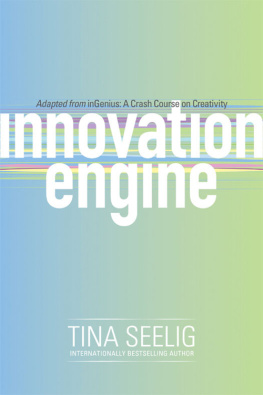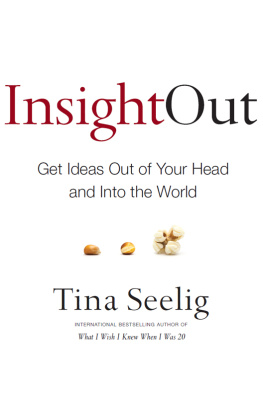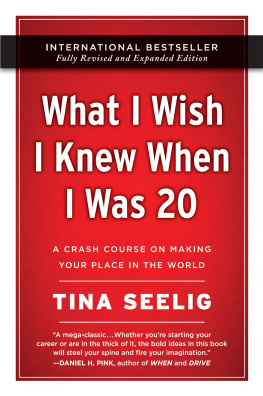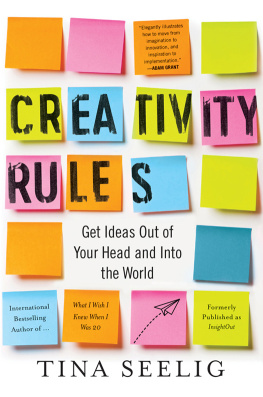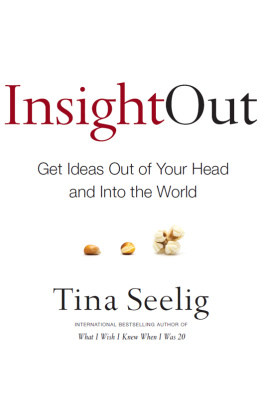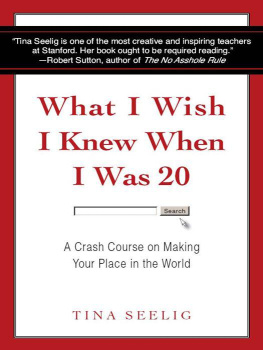CONTENTS
As children, we naturally engage our curiosity and imagination in an attempt to make sense of the complicated world around us. We experiment with everything in our midst, grabbing objects to see how they feel, dropping them to see how far they fall, and banging them to see how they sound. We mix together random cooking ingredients to see how they taste, make up games with ever-changing rules, and fantasize about what it would be like to live in outer space.
As we approach adulthood, however, we too often forget how to be creative. We give up playing and focus on producing, swapping imagination for implementation.
The good news is it doesnt have to be this way.
The human brain evolved over millions of years into a fabulously complex organ that is optimized for innovation. With input from all our senses, it is always assessing our ever-changing environment and generating fresh responses to fit each situation. Each stimulus, no matter how small, can jump-start creativity.
Let me demonstrate this with a single word.
Until recently, prospective students at All Souls College, at the University of Oxford, took a one-word exam. The Essayas it was calledwas eagerly anticipated by applicants. They would each flip over a piece of paper at the same time to reveal one word. It might have been innocence or miracles or water. Their challenge was to craft an essay in three hours inspired by that single word.
There were no right answers to this exam. However, each response provided insights into the applicants wealth of knowledge and ability to generate creative connections. The New York Times quotes one Oxford professor as saying, The unveiling of the word was once an event of such excitement that even non-applicants reportedly gathered outside the college each year, waiting for news to waft out.
For so many of us, this type of creativity hasnt been fostered. We dont see our entire environment as a source of opportunities for ingenuity. Yet, creativity should be an imperative, and we should look at everything around us for inspiration. Creativity allows us to thrive in a changing world and unlocks a universe of possibilities. As the renowned American inventor Alan Kay famously said, The best way to predict the future is to invent it. We are all inventors of our own future. And creativity is at the heart of invention.
For centuries people have questioned these natural talents and looked outside themselves for a source of creative inspiration. The ancient Greeks believed there were goddesses, called Muses, who inspired literature and art, and they worshipped them for their powers. Ideas often feel inspired and, therefore, it made sense to beg a muse for inspiration.
Your creativity is, in fact, an endless renewable resource, and you can tap it at any time.
After a dozen years teaching courses on creativity and entrepreneurship in the department of Management Science and Engineering at Stanford University, I can confidently assert that creativity can be enhanced. A concrete set of methods and environmental factors can be used to intensify your imagination, and by optimizing these variables, your creativity naturally increases. I call this collection of factors the Innovation Engine.
The Innovation Engine, shown in the following figure, illustrates how creativity results from the interplay between your internal world and the external environment. It reveals a set of techniques you can use right away to evaluate and expand your creativity and that of your team, organization, or community. Using these techniques, you can improve your ability to see opportunities around you and creatively tackle challenges of all sizes.
The Innovation Engine has two partsthe inside and the outsidebraided together. On the inside are imagination, knowledge, and attitude:
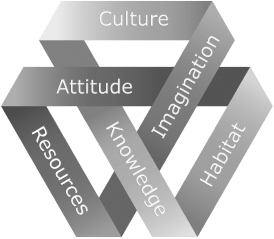
Your imagination is the catalyst for the transformation of knowledge into new ideas.
Your attitude is the spark that sets the Innovation Engine in motion.
Your knowledge is the toolbox for your imagination.
The three parts on the outside are habitat, resources, and culture:
Resources are all the assets in your community.
Habitat includes the rules, rewards, physical spaces, and people in your environment.
Culture is the collective beliefs, values, and behaviors in your community.
All these factors fit together and profoundly influence one another. Like creativity, at first glance this model might look complex. Over the course of this book, I will take apart the Innovation Engine and examine its six components more closely. Then, Ill put it back together and show how all the parts work in concert and influence one another to enhance creativity.
There is a common theme: creativity is not just something you think about; it is something you do. In the following chapters, you will learn how to jump-start your Innovation Engine and see how every word, every object, every idea, and every moment provides an opportunity for creativity.
What is the sum of five plus five?
What two numbers add up to ten?
The first question has only one right answer, but the second question has an infinite number of solutions, including negative numbers, decimals, and fractions. To me, this is remarkable! It led to the profound insight that each question we ask is the frame into which the answers will fall. As you can see, by changing the question you ask, you dramatically change the range of possible solutions.
Mastering the ability to reframe problems is an important tool for increasing your imagination, because it unlocks a vast array of solutions. Taking photos provides a good example. When taking a picture on the shore of a lake, you might use a wide-angle lens to capture the entire scene, photograph the trees close to the shore, or focus extremely close on a single wildflower or a ladybug on that flower. By just shifting your field of view up or down, or panning left or right, you completely change the image. Of course, if you walk to the other side of the lake, climb to the top of a nearby peak, or take a boat out onto the water, you shift the frame further.
In most cases, we dont even consider the frames we usewe assume we are looking at the world with the proper set of lenses. However, being able to question and shift our frames of reference are important to enhancing our imagination, because doing so reveals completely different insights.
Consider the fact that before 1543 people believed the sun and all the planets revolved around the earth. To all those who looked to the sky it seemed obvious that the earth was the center of the universe. But in 1543, Copernicus proposed that the sun was actually at the center of the solar system. This was a radical change in perspectiveor frameand resulted in what we now call the Copernican Revolution. This shift in point of view, in which the earth is seen as but one of many planets circling the sun, dramatically altered the way individuals thought about the universe and their individual roles within it. It opened up the world of astronomy and provided a new platform for inquiry.
This type of thinking can be applied to any industry anywhere in the world. For example, the directors of Tesco, a food-marketing business in South Korea, set a goal to increase the companys market share substantially, and they needed to find a creative way to do so. They realized that the lives of their customers were so busy it was actually quite stressful for them to find the time to go shopping. So, instead of bringing more customers to Tescos stores, the directors decided to bring their store to more customers! They completely reframed the shopping experience by taking photos of the food aisles and putting up full-size images in city subway stations. People could shop while they waited for a train, using their smartphones to take and send photos of an items QR code and paying by credit card. The items were then delivered to them at home. This new approach to shopping boosted Tescos sales significantly.

